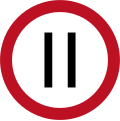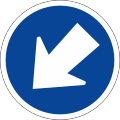
Road signs in Indonesia are standardized road signs similar to those used in other nations but with certain distinctions. As a former Dutch colony, until the 1970s road signs in Indonesia closely followed The Netherlands rules on road signs. Nowadays, Indonesian road sign design are a mix of European, US MUTCD, Australia, New Zealand and Japanese road sign features. According to the 2014 Minister of Transport's Regulation No. 13 concerning Traffic Signs, [1] the official typeface for road signs in Indonesia is Clearview. Indonesia formerly used FHWA Series fonts (Highway Gothic) as the designated typeface though the rules are not being implemented properly.
Contents
- Warning signs
- Intersections
- Regulatory signs
- Prohibitory signs
- Mandatory signs
- Directional signs
- Toll Road signs
- Information signs
- Temporary signs
- Electronic signs
- Warning signs 2
- Regulatory signs 2
- Information signs 2
- See also
- References
Indonesian road signs use Indonesian, the official and the national language of Indonesia. However, English is also used for important public places such as tourist attractions and airports. Bilingual signs can be found in tourist areas such as Bali.
Indonesia signed the 1968 Vienna Convention on Road Signs and Signals but have yet to ratify the Convention. [2] Indonesia drives on the left.









































































































































































































































































































